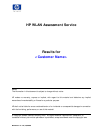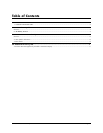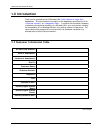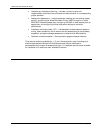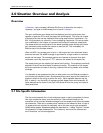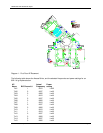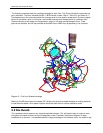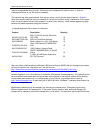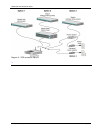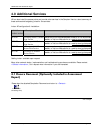
HP Wireless LAN Assessment Report
HP Internal Use Only Page 6
3.0 Situation Overview and Analysis
Overview
<Customer> has purchased a Wireless Site Survey to determine the location,
frequency, and type of wLAN access point to use at <location>.
The open conference room design and the sheetrock and stud construction work
together to pass the RF to cover the areas with wLAN signals. This limits the number
of access points that can be installed without using same channel interference. The
802.11b/g standard only allows for 3 non-overlapping frequencies. This survey takes
into consideration, the number of users and the numbers of users per access point.
The access points are configured with the lowest possible power settings and lowest
gain antennas to help reduce the number of users per AP. This is necessary for
effective use of the wireless network.
When the 802.11b/g access point is set to 1 mW output and omni directional dipole
antennas are used, the wLAN coverage is optimized for a large number of users and
smaller cell coverage. The coverage patterns are intended to be small since each
conference room may have up to <???> users on the network at the same time.
The access points can be installed just above the tile ceiling. The antennas are directly
attached to the AP and should also be above the ceiling. The locations of the access
points are optimized for ease of mounting, distance from wiring closets, and wireless
coverage.
It is desirable to use access points that can take power over the Ethernet connection
to minimize the installation costs. Some access points would require the installation of
electrical outlets in the ceiling to power the units. Other desirable features may be
802.1x security, and the ability to manage multiple Access Points simultaneously. All
these features can be found in the Cisco 1200 series AP that the survey tool used for
these predictions.
3.1 Site Specific Information
The first and mezzanine floor of the conference center is mainly comprised of the two
floor high conference rooms, and the auditorium. Some offices located on the
mezzanine will be provided wireless coverage from the access points above and below
the mezzanine. There are no access points installed on the mezzanine level. A total of
14 access points are required to completely cover this area and provide acceptable
WLAN access speeds. Acceptable speeds are described as 11 Mbps. Diagram 1 shows
the placement of these access points. The circles only show that the antennas are
omni directional, not the coverage area.



